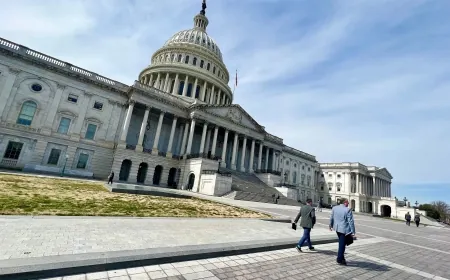U.S. Treasury Bonds Under Pressure: Investors Demand Higher Yields on Long-Term Debt
Investor fears over U.S. deficits and Trump’s policies drive long-term Treasury yields higher, raising risks for government borrowing and markets.

Investor caution toward U.S. government bonds is deepening, particularly for longer maturities that have traditionally been seen as a safe bet. A sharp selloff this month has left a mark on investor sentiment, with concerns mounting about how America’s growing deficits and unpredictable policy moves could reshape the bond market.
Uncertainty surrounding President Donald Trump’s policies — from tariffs to tax reforms — has added fresh worries to a market already balancing inflation risks and slowing economic growth. Investors are increasingly demanding higher yields to hold longer-term bonds, challenging the U.S. government's ability to borrow at low costs.
The term premium, the extra yield investors seek to guard against risks over time, has climbed to one of its highest points since 2014. Analysts expect this trend to persist even if some immediate concerns over trade policy ease.
Caution Deepens Across Bond Markets
Even though investors are not abandoning Treasuries entirely, many are adjusting their positions to avoid long exposure. Recent auctions of 30-year bonds showed continued demand — but only at sharply higher yields compared to past sales, revealing a more cautious stance.
Major asset managers are favoring shorter maturities. Firms such as Pacific Investment Management Co. and Vanguard Group are focusing on five- to ten-year bonds, where they feel more comfortable balancing return against risk. Inflation-adjusted yields on 30-year bonds recently touched levels not seen since the 2008 financial crisis before easing slightly.
Yields on 30-year nominal debt rose four basis points to 4.74% on Monday, breaking a four-day streak of declines and reflecting continued unease about the long-term outlook.
Vanguard analysts pointed out that the term premium, while elevated, could rise even further if federal deficits continue to widen without a clear fiscal plan. The firm expects U.S. economic growth to slow to below 1% this year, a pace not seen since the pandemic lockdowns of 2020, which could put additional strain on government budgets.
Higher Borrowing Costs Reach Beyond Wall Street
The impact of rising long-term yields goes far beyond investors. Higher Treasury yields often push up mortgage rates, raising the cost of buying homes and making credit more expensive for businesses. For consumers, this can translate into higher loan costs across mortgages, auto loans, and credit cards.
For the federal government, the stakes are even higher. Every small increase in long-term rates adds billions to annual debt servicing costs, which are already projected to exceed $1 trillion this year. Without a credible plan to control deficits, the rising cost of borrowing could weigh heavily on future government spending decisions.
Treasury’s Next Moves Under Scrutiny
This week, attention turns to the U.S. Treasury’s quarterly refunding announcement. Market expectations are for steady auction sizes over the next three months. However, any surprise increase in debt issuance could unsettle investors already wary of absorbing higher supply.
Meanwhile, Washington’s ongoing debates over how to fund recent tax cuts without deepening the deficit could influence market sentiment further. If the government signals more aggressive borrowing without matching spending restraint, yields could push even higher.
George Catrambone of DWS Americas noted that greater clarity on trade and fiscal issues could ease some of the pressure on long-term yields, but not return them to the low levels seen over the past decade. He stressed that fiscal challenges are likely to remain a constant factor weighing on bond valuations.
Key Developments Investors Are Watching
Several important economic reports and events could influence bond markets in the days ahead:
-
April 28: Dallas Fed manufacturing activity report
-
April 29: Advance goods trade balance, wholesale and retail inventories, housing data, consumer confidence measures
-
April 30: First-quarter GDP, personal income and spending, inflation updates (PCE price index), pending home sales
-
May 1: New jobless claims, manufacturing activity reports
-
May 2: Non-farm payrolls, factory and durable goods orders
Additionally, the Federal Reserve has entered its communication blackout period before its May 7 policy decision. Traders will be closely monitoring the Treasury’s auction schedule and the broader supply of new debt as well.
Investors Brace for a Tougher Treasury Market
Uncertainty surrounding U.S. fiscal policy and rising borrowing needs are pushing bond investors to demand greater compensation for holding longer-term debt. As the Treasury prepares to outline its funding strategy, investors are weighing whether upcoming auctions can sustain demand without driving yields even higher.
Concerns over widening deficits, unpredictable trade measures, and pressure on Federal Reserve independence have shifted the perception of long bonds from a traditional safe haven to an asset requiring greater caution. Without a clearer signal from Washington on stabilizing fiscal conditions, the market for long-term U.S. debt is expected to remain unsettled.
Also Read: Nvidia Sinks 6% on U.S. AI Chip Ban as Asia Markets Dive on China GDP, Tariff Shock































































